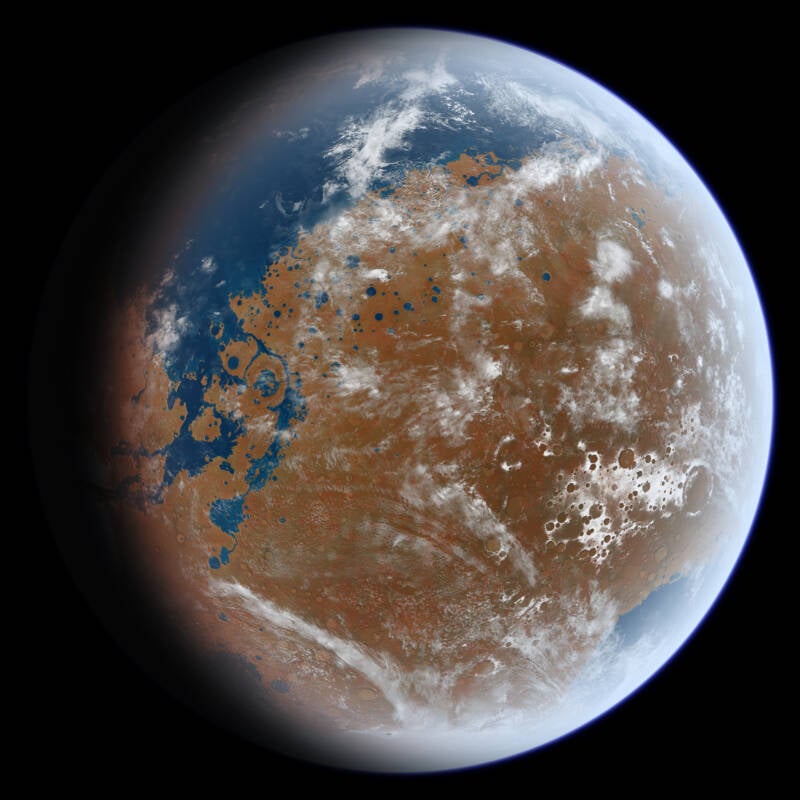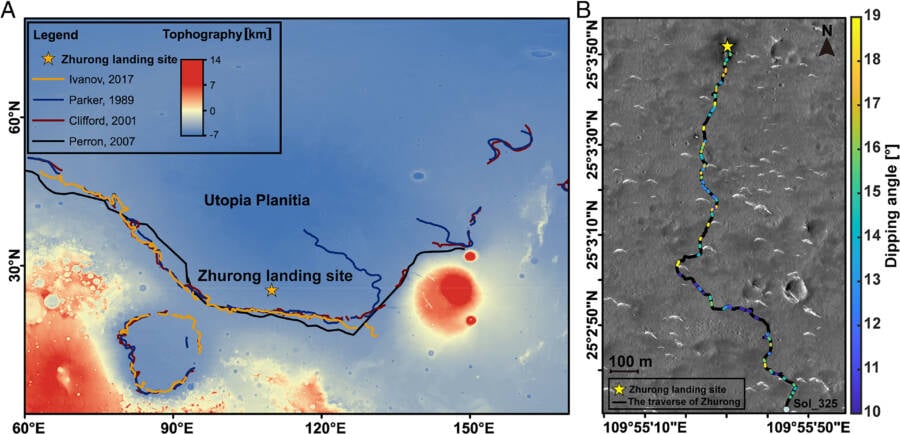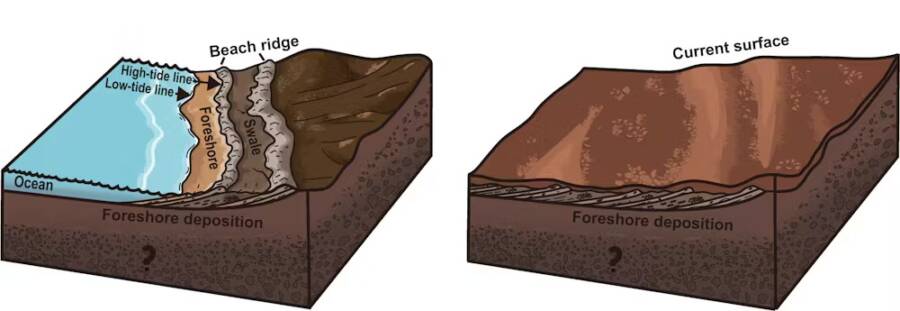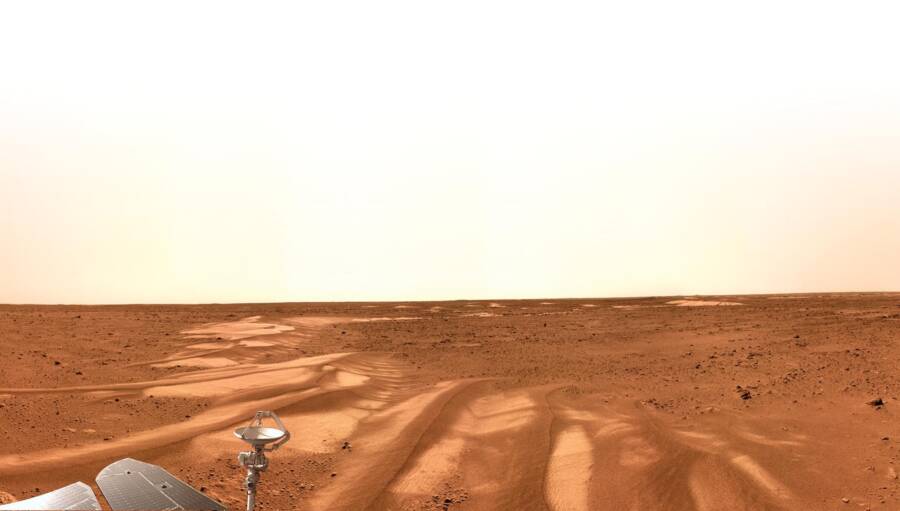Based on geological data gathered by China's Zhurong rover, researchers believe they have found evidence of beaches on Mars, adding further credence to the theory that the Red Planet was once covered in liquid water.

Ittiz/Wikimedia CommonsAn artist’s interpretation of what the surface of ancient Mars may have looked like based on geological data.
Billions of years ago, Mars may have looked very different. The Mars ocean theory has been a subject of scientific debate and focus for the better part of 50 years now, ever since NASA’s Mariner 9 orbiter first captured evidence of water-sculpted surfaces on the planet back in the 1970s.
But the extent of how much water once covered Mars’ surface is still somewhat murky. Analysis of meteorites, for example, has shown that water was on the planet’s surface roughly 4.5 billion years ago, and some more recent evidence suggests there may still be ice beneath its surface today. Other research has identified valley networks and sedimentary rocks that could suggest the Red Planet was covered in flowing rivers at one point in its history.
However, a new study published in the Proceedings of the National Academy of Sciences is now providing more evidence of Mars’ oceans thanks to the discovery of buried beaches across the planet’s surface.
Scientists Find Evidence Of Buried Beaches On Mars
This new study was a joint effort between American and Chinese scientists led by Jianhui Li from Guangzhou University in China. The team analyzed ground imaging data from China’s Zhurong rover, which they claim shows evidence of what they are calling “paleoshorelines” across Mars.
“Through radar data gathered by the Zhurong Rover, we identify extensive dipping deposits in the subsurface of southern Utopia Planitia,” the researchers wrote in the study. “These deposits have structures similar to those of Earth’s coastal sediments. This finding implies the past existence of a large water body, supporting the hypothesis of a past ocean in the northern plains of Mars.”

Hai Liu/Guangzhou UniversityThe Zhurong rover’s landing site.
The Chinese National Space Administration launched Zhurong in 2020, and the rover spent two years actively scanning Mars’ surface in 2021 and 2022. It touched down within Utopia Planitia, a plain within a large impact basin on Mars that stretches more than 2,000 miles in diameter. Satellite data had previously mapped ridges believed to be paleoshorelines across Utopia Planitia, making it the ideal place for Zhurong to start looking.
When they looked at what Zhurong found, the researchers noticed consistencies between Mars’ subsurface material and Earth’s, noting a tilt towards the lowland, or ocean, at an angle similar to that of Earth’s beaches.

Hai Liu/Guangzhou UniversityA diagram showing how a series of beach deposits would have formed in the distant past on Mars.
“Typically the radar picks up on even subtle changes in sediment size, which is probably what’s happening here,” study co-author Benjamin Cardenas of Penn State University told The Guardian.
According to Cardenas, the data also indicated that the beach seemed to shift position over time. The data showed a series of features dipping toward the north, which likely means the beach grew out into the ocean.
“It’s a simple structure, but it tells you there had to be tides, there had to be waves, there had to be a nearby river supplying sediment, and all these things had to be active for some extended period of time,” Cardenas said. Moreover, no other geological activity that could cause tilted features properly explains this data, leaving little room for other interpretations.
“We rule out volcanic, rivers, and wind-blown sand dunes. All of these are pretty commonly seen on Mars, but the structure just doesn’t fit any of them,” Cardenas added.
Implications For The Existence Of Extraterrestrial Life

He Zhu/Wikimedia CommonsThe surface of Mars photographed by the Zhurong rover.
While the idea of oceans and beaches on Mars existing billions of years ago may not initially seem that important to people who are alive today, these features could have larger implications for Mars’ habitability — and the search for extraterrestrial life.
“Mars expresses Earth-like geological features, seasonal cycles, and day–night rhythm making it a unique analog to the evolution of the Earth and informing the search for extraterrestrial life,” researchers wrote in the study. “Although the surface of present-day Mars is cold and dry, geological features such as valley networks, open- and closed-basin lakes, deltas, alluvial fans, pitted-cones, and sedimentary rocks support the prior existence of vast amounts of liquid water.”
If so, then at some point in the distant past, nearly one-third of the Red Planet was covered by oceans.
“A beach is an interface between shallow water, air, and land,” Cardenas said. “It’s these sorts of environments where it’s thought life first came to be on Earth, and I think it would be a great place to send a follow-up mission looking for signs of past life [on Mars].”
After reading about the discovery of a possible beach on Mars, learn more about humanity’s search for life on the Red Planet. Then, explore Mars’ surface through our gallery of awe-inspiring photographs.





